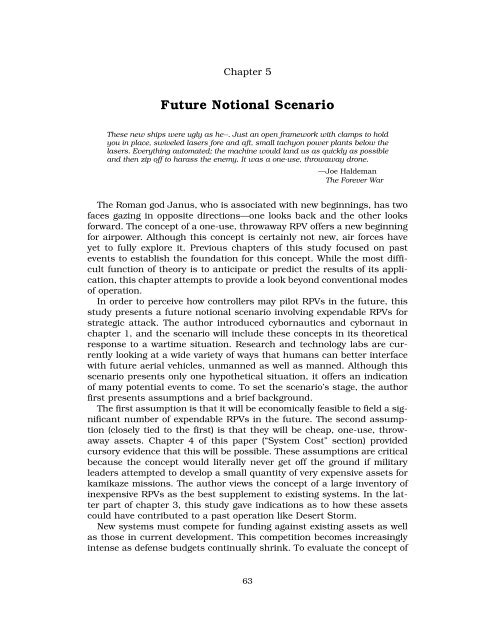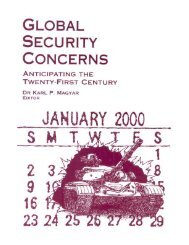Expendable Remotely Piloted Vehicles for Strategic Offensive ...
Expendable Remotely Piloted Vehicles for Strategic Offensive ...
Expendable Remotely Piloted Vehicles for Strategic Offensive ...
Create successful ePaper yourself
Turn your PDF publications into a flip-book with our unique Google optimized e-Paper software.
Chapter 5Future Notional ScenarioThese new ships were ugly as he--. Just an open framework with clamps to holdyou in place, swiveled lasers <strong>for</strong>e and aft, small tachyon power plants below thelasers. Everything automated; the machine would land us as quickly as possibleand then zip off to harass the enemy. It was a one-use, throwaway drone.—Joe HaldemanThe Forever WarThe Roman god Janus, who is associated with new beginnings, has twofaces gazing in opposite directions—one looks back and the other looks<strong>for</strong>ward. The concept of a one-use, throwaway RPV offers a new beginning<strong>for</strong> airpower. Although this concept is certainly not new, air <strong>for</strong>ces haveyet to fully explore it. Previous chapters of this study focused on pastevents to establish the foundation <strong>for</strong> this concept. While the most difficultfunction of theory is to anticipate or predict the results of its application,this chapter attempts to provide a look beyond conventional modesof operation.In order to perceive how controllers may pilot RPVs in the future, thisstudy presents a future notional scenario involving expendable RPVs <strong>for</strong>strategic attack. The author introduced cybornautics and cybornaut inchapter 1, and the scenario will include these concepts in its theoreticalresponse to a wartime situation. Research and technology labs are currentlylooking at a wide variety of ways that humans can better interfacewith future aerial vehicles, unmanned as well as manned. Although thisscenario presents only one hypothetical situation, it offers an indicationof many potential events to come. To set the scenario’s stage, the authorfirst presents assumptions and a brief background.The first assumption is that it will be economically feasible to field a significantnumber of expendable RPVs in the future. The second assumption(closely tied to the first) is that they will be cheap, one-use, throwawayassets. Chapter 4 of this paper (“System Cost” section) providedcursory evidence that this will be possible. These assumptions are criticalbecause the concept would literally never get off the ground if militaryleaders attempted to develop a small quantity of very expensive assets <strong>for</strong>kamikaze missions. The author views the concept of a large inventory ofinexpensive RPVs as the best supplement to existing systems. In the latterpart of chapter 3, this study gave indications as to how these assetscould have contributed to a past operation like Desert Storm.New systems must compete <strong>for</strong> funding against existing assets as wellas those in current development. This competition becomes increasinglyintense as defense budgets continually shrink. To evaluate the concept of63






